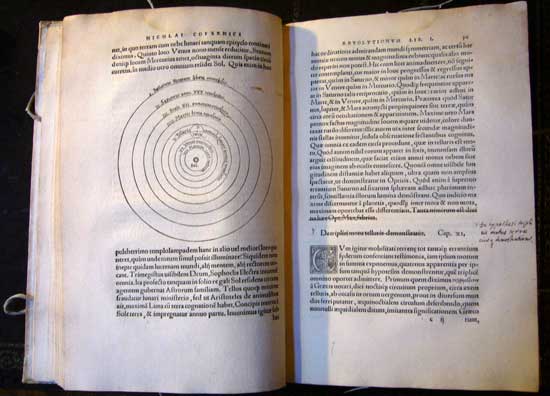Highlights

Copernicus, Nicolaus (1473-1543)
De revolutionibus orbis coelestium
Nuremberg: Joannes Petreius, 1543
 F
F
irst edition of the most significant scientific publication of the sixteenth century contributing to clarify the relationship of man and his universe "The publication of 'On the Revolutions of the Celestial Spheres' in 1543 was a landmark in human thought. It challenged the authority of antiquity and set a course for the modern world by its effective destruction of the anthropocentric view of the universe.
Copernicus had thought about, developed, discussed, and circulated in manuscript his theory of the heliocentric universe many years before deciding, shortly before his death, to allow De revolutionibus to be seen through the press. Similarly to Darwin, who two centuries later withheld from the public his theory of natural selection until being forced to publish, Copernicus seemed to want to avoid both controversy and ridicule. The book had a small but highly significant readership, including, Tycho Brahe, Johannes Kepler, Galileo Galilei, Georg Joachim Rheticus, Erasmus Reinhold, Michael Maestlin, Johann Schoner, and Christopher Clavius.
Copernicus was indisputably the first great astronomer of modern times; the first to assign the Earth its proper planetary status and the first to provide a scientific justification for placing the sun near the centre of the known universe.
De revolutionibus was placed on the Index librorum prohibitorum in 1616  , and a desultory attempt was made to censor copies in circulation; this effort was carried out with any regularity only in Italy. The Copernican cosmology was unchallenged by the Catholic Church for more than seventy years for a number of reasons: Andreas Osiander's anonymous (and unauthorized) preface presented De revolutionibus as a strictly hypothetical system invented as an convenient calculating device that could well be false even if the Copernican system was consistent with astronomical observations; the system had pragmatic applications for calendrical purposes. Copies of De revolutionibus were "corrected" principally in an attempt to counteract Galileo's teaching about the reality of the Copernican system, but the many decades elapsed since the work had appeared frustrated the Church´s attempt to systematically censor it and in 1835 the Church quietly dropped its ban on the work.
, and a desultory attempt was made to censor copies in circulation; this effort was carried out with any regularity only in Italy. The Copernican cosmology was unchallenged by the Catholic Church for more than seventy years for a number of reasons: Andreas Osiander's anonymous (and unauthorized) preface presented De revolutionibus as a strictly hypothetical system invented as an convenient calculating device that could well be false even if the Copernican system was consistent with astronomical observations; the system had pragmatic applications for calendrical purposes. Copies of De revolutionibus were "corrected" principally in an attempt to counteract Galileo's teaching about the reality of the Copernican system, but the many decades elapsed since the work had appeared frustrated the Church´s attempt to systematically censor it and in 1835 the Church quietly dropped its ban on the work.
Page caption:
 This copy of the book is corrected by a contemporary hand according to the requirements of the Church. Thus the last sentence of chapter X : “This is without doubt the size of the Optimus Maximus´ Divine creation” is deleted. Furthermore the title of chapter XI is changed according to the ink notation from “Proof of the threefold movement of the earth” to “On the hypothesis of the threefold movement of the earth and on its proof.”
This copy of the book is corrected by a contemporary hand according to the requirements of the Church. Thus the last sentence of chapter X : “This is without doubt the size of the Optimus Maximus´ Divine creation” is deleted. Furthermore the title of chapter XI is changed according to the ink notation from “Proof of the threefold movement of the earth” to “On the hypothesis of the threefold movement of the earth and on its proof.”

